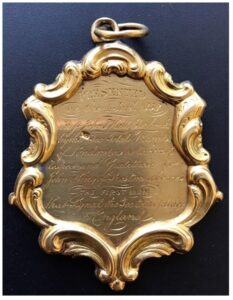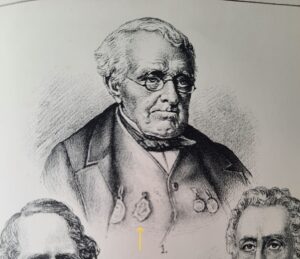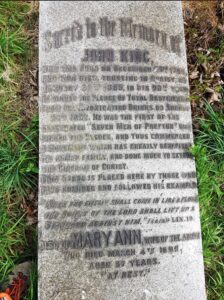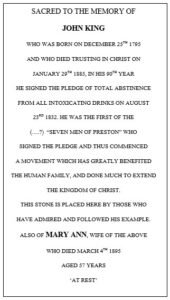I have recently been cataloguing our collection of temperance badges and medals, item by item. It has taken me some time to be able to get to the point of being able to examine these pieces in further detail. One particular piece caught my attention as being particularly significant, due its connection to a man who appeared right at the beginning of the history of the temperance movement in this country.
This item is a gold medal with an inscription stating that it was presented to John King in 1858. Alongside Joseph Livesey, John King was one of the ‘Seven Men of Preston’, and significantly he was the first of these to sign the pledge of total abstinence in Preston in 1832.
The inscription on the front and back of the medal reads, ‘JOHN KING born 25th Dec 1795 Signed the Tee Total Pledge 23rd August 1832’,‘Presented on the 4th Jany 1858 in St Johns Hall Clerkenwell by the Tee Total Friends of London as a token of respect and gratitude to John King of Preston who was THE FIRST MAN that signed the Tee Total Pledge in England’
 Research of the hallmarks appear to confirm the date period for this medal. The leopard’s head mark denotes a London Assay Office and the standard mark denotes the purity of the metal. 18ct antique gold is indicated by the crown mark and a numeral 18.
Research of the hallmarks appear to confirm the date period for this medal. The leopard’s head mark denotes a London Assay Office and the standard mark denotes the purity of the metal. 18ct antique gold is indicated by the crown mark and a numeral 18.
 The date mark relates to when the piece was assayed and not necessarily when it was made, with these marks being unique to each assay office. The London date mark on our medal represents 1857, which ties in nicely with the presentation date of 1858 inscribed on the medal.
The date mark relates to when the piece was assayed and not necessarily when it was made, with these marks being unique to each assay office. The London date mark on our medal represents 1857, which ties in nicely with the presentation date of 1858 inscribed on the medal.
I wanted to find out more about John King, and his place in the history of the temperance movement in England. An internet search yielded some information, but I was unable to find an image of King until I went back to our own book collection.
‘The Temperance Movement and it’s Workers’ by P T Winskill, is a comprehensive historical record of ‘Social, Moral, Religious, and Political Progress’ and we are lucky enough to hold volumes I-IV from 1891-1892, in our book collection. This is where I was excited to find the following image of King –
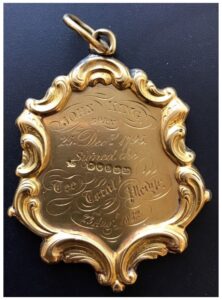 Even more interestingly, he is shown wearing his medals and the one I have highlighted with the arrow on the image, looks remarkably similar in shape to our medal. The medal illustrated has a very distinctive style and is quite different from the other round medals he is wearing. Could the medal in our collection be the very same one that King is shown wearing in this image?
Even more interestingly, he is shown wearing his medals and the one I have highlighted with the arrow on the image, looks remarkably similar in shape to our medal. The medal illustrated has a very distinctive style and is quite different from the other round medals he is wearing. Could the medal in our collection be the very same one that King is shown wearing in this image?
Further reading of Winskill resulted in the following reference to King and the gold medal he was presented with. The wording matches precisely with the inscription on the medal in our collection –
‘On his second visit to London the teetotallers presented him with a gold medal bearing his name, date of birth, and when he signed the pledge, as well as the following inscription:- “Presented, January 4th, 1858, in St John’s Hall , Clerkenwell, by teetotal friends in London, as a token of respect and gratitude, to John King of Preston, who was the first man that signed the teetotal pledge in England.”
References to the medals he received for his temperance work are also found in an article in The Manchester Guardian of 30th January 1885, which includes the gold one presented at St John’s Hall, Clerkenwell. The same matching inscription is recorded again. It adds further weight along with the date marks, to my belief that our medal is indeed the one presented to King in 1858 and worn so proudly by him for his services to the temperance cause.
John King and the Seven Men of Preston
King was born on 25th December 1795 at Walton-le-Dale near Preston, Lancashire to parents who belonged to the Society of Friends or Quakers. It is reported that he disliked school life and went on to be an apprentice to his father to learn the trade of clogger or clog maker. Hard wearing leather work clogs were required by people working in the local factories.
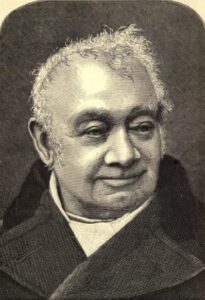 Joseph Livesey, one of the early teetotal pioneers of the temperance movement was also born in Walton-le-Dale, in 1794, the year before King. Livesey was a weaver and went on to become a cheesemonger, with a shop in Church Street, Preston.
Joseph Livesey, one of the early teetotal pioneers of the temperance movement was also born in Walton-le-Dale, in 1794, the year before King. Livesey was a weaver and went on to become a cheesemonger, with a shop in Church Street, Preston.
As a leading temperance advocate, Livesey was a philanthropist, social reformer, writer and founding member of the Preston Temperance Society in 1832, of which King was also a member. It is recorded that they were co-workers and King visited people in their own homes alongside Livesey and others with the temperance message.
The aim of many of the early temperance campaigners was to moderate the consumption of alcohol but the pledge drawn up by Livesey and signed in the first instance by King, was significantly different. Livesey believed that only total abstinence was acceptable to alleviate drunkenness and dependance on alcohol and so the first ‘teetotal’ pledge was drawn up.
Livesey described the circumstances in which he and King signed this pledge in his ‘Reminiscences of Early Teetotalism’ –
“One Thursday (August 23, 1832), John King was passing my shop in Church-street and I invited him in, and after discussing this question, upon which we were both agreed, I asked him if he would sign a pledge of total abstinence, to which he consented. I then went to the desk and wrote one out (the precise words of which I don’t remember). He came up to the desk, and I said, ‘Thee sign it first.’ He did so, and I signed after him.
“This first step led to the next, for in the course of a few days notice of a special meeting was given, to be held in the Temperance Hall (the Cockpit) the following Saturday night, September 1, at which this subject was warmly discussed. At the close of the meeting I remember well a group of us gathering together, still further debating that matter, which ended in seven persons signing a new pledge.”
The pledge read:– “We agree to abstain from all liquors of an intoxicating quality, whether ale, porter, wine, or ardent spirits, except as medicines.”
The seven men who signed the pledge of total abstinence on that night, including King and Livesey became known as the Seven Men of Preston. This was the beginning of a hugely influential social movement of the 19th century and John King was right at the forefront of the story alongside the more widely known Livesey.
What happened to John King after 1832?
By 1834, King had left Preston for work purposes and was involved in establishing the Chester Temperance Society and others. He also went to Nottinghamshire where he went to break up clog soles. Around 1837 he returned to Preston and eventually gave up business as a clogger, going to work on the Lancashire and Yorkshire Railway. He was appointed stationmaster at Lea Road near Preston and later at Ainsdale.
In 1857 King had an accident which placed him under the care of a doctor in London and he made two visits there. Winskill records that it was during one of these visits that he was presented with the gold medal at St John’s Hall, Clerkenwell by teetotal friends of London.
King went to Bescar Lane in 1871, where he was in charge of a gatehouse and crossing, with the assistance of his wife. This was after he had experienced issues with his eyesight and had been to London for an ophthalmic operation.
By 1873 King was experiencing further difficulties, and a pension was set up for him by the Good Templars and other temperance friends, showing their high regard for him. This provided King with an annuity at an age when he presumably was no longer able to work.
The 50th anniversary year of the signing of the first teetotal pledge was celebrated in September 1882, when King was in his 87th year and the Manchester Courier reports that Mr King was present at the celebrations. King ‘was upon the platform in the full possession of his faculties, and looking remarkably well’. Temperance societies marched through Preston and King rode in a ‘dogcart’ near the end of the procession and ‘attracted considerable notice. He wore on his breast a number of gold and silver medals, all presented to him in token of his eminent services in the temperance cause….’.
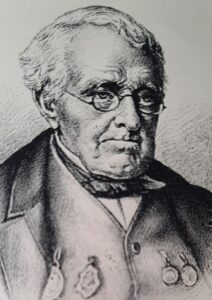 Something of King’s strength of character can be gleaned from the length of his working years, and his ability to attend this temperance celebration at the age of 86, whilst proudly bearing his temperance medals.
Something of King’s strength of character can be gleaned from the length of his working years, and his ability to attend this temperance celebration at the age of 86, whilst proudly bearing his temperance medals.
Winskill records that ‘One of Mr Kings leading characteristics was his indomitable firmness, or power of self-control. He was remarkable for his ability to say ‘Yes’ or ‘No….and whatever he resolved to do, if it was within his power, John King would do it.’
He smoked tobacco but once he had resolved to quit then he never smoked again. He also gave up his snuff habit. A friend agreed to give up his own drinking if John would give up his ‘snuffing’. Even though this friend broke his promise, John never took up the habit again.
In the cause of temperance, King was described as ‘an earnest, faithful, and laborious worker….and to the very last took a deep interest in its welfare’. He died at on 29th January 1885 aged 89 years and his memorial stone and that of his wife Mary Ann, lies in Duke Street Cemetery, Southport. It reads,
Thanks to Kevin Laroux Wood for permission to use image of memorial stone
Sources
The Temperance Movement and it’s Workers, A Record of Social, Moral, Religious, and Political Progress Vol I – IV, P T Winskill 1891
British Newspaper Archives
The Manchester Guardian 30th January 1885
Image of John King – The Temperance Movement and it’s Workers A Record of Social, Moral, Religious, and Political Progress by P. T. Winskill, Vol II, pp146

